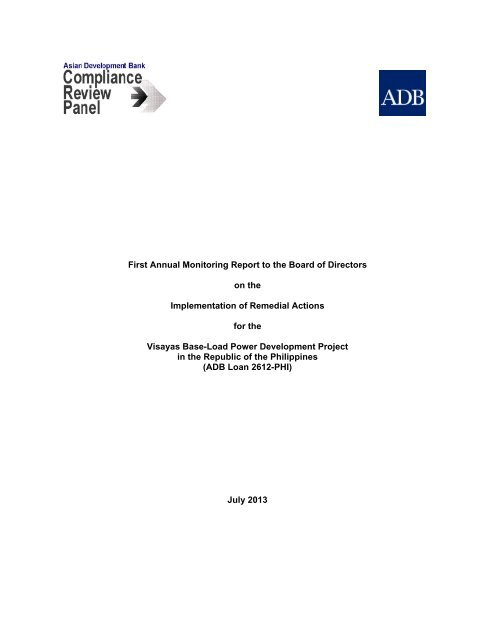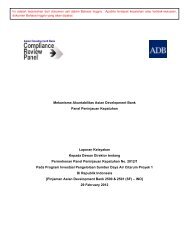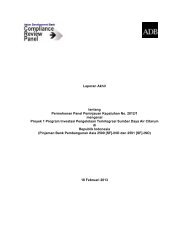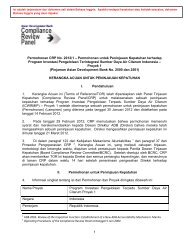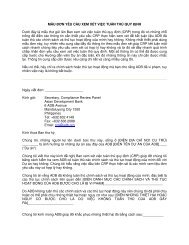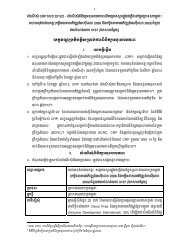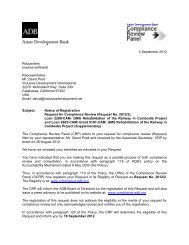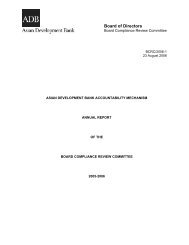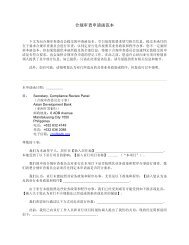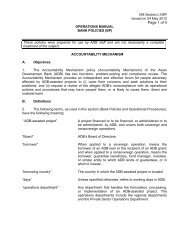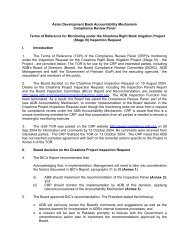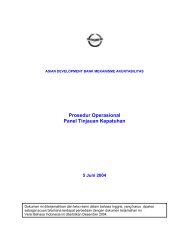Annual Monitoring Report - ADB Compliance Review Panel - Asian ...
Annual Monitoring Report - ADB Compliance Review Panel - Asian ...
Annual Monitoring Report - ADB Compliance Review Panel - Asian ...
Create successful ePaper yourself
Turn your PDF publications into a flip-book with our unique Google optimized e-Paper software.
First <strong>Annual</strong> <strong>Monitoring</strong> <strong>Report</strong> to the Board of Directors<br />
on the<br />
Implementation of Remedial Actions<br />
for the<br />
Visayas Base-Load Power Development Project<br />
in the Republic of the Philippines<br />
(<strong>ADB</strong> Loan 2612-PHI)<br />
July 2013
CONTENTS<br />
Page<br />
Acknowledgments……………………………………………………………………………..<br />
Abbreviations…………………………………………………………………………………..<br />
iv<br />
v<br />
I. INTRODUCTION………………………………………………………………………… 1<br />
II. DESCRIPTION OF THE PROJECT…………………………………………………… 2<br />
III. COMPLIANCE REVIEW AND RECOMMENDATIONS…………………………….. 2<br />
IV. RESULTS OF THE MONITORING OF THE ACTION PLAN………………………. 3<br />
V. CONCLUSIONS…………………………………………………………………………. 13<br />
Appendix<br />
1. List of Persons Met During the <strong>Compliance</strong> <strong>Review</strong> <strong>Monitoring</strong> Mission…... 17<br />
2. Management's Action Plan for Implementing the Recommendations of the<br />
<strong>Compliance</strong> <strong>Review</strong> <strong>Panel</strong>…………………………………………………………… 18
iv<br />
ACKNOWLEDGMENTS<br />
The <strong>Compliance</strong> <strong>Review</strong> <strong>Panel</strong> acknowledges all those who have contributed to the<br />
preparation of this report and thanks the following:<br />
<br />
<br />
<br />
<br />
<br />
<br />
the <strong>Asian</strong> Development Bank (<strong>ADB</strong>) Board of Directors, in particular the<br />
members of the Board <strong>Compliance</strong> <strong>Review</strong> Committee;<br />
the staff of the Private Sector Operations Department, <strong>ADB</strong>;<br />
the requesting parties, who have asked that their identities be kept confidential,<br />
for their trust in the compliance review process;<br />
the project sponsor, KEPCO-SPC Power Corporation;<br />
the staff of APO Cement Corporation (main ash recycler); and<br />
the Government of the Republic of the Philippines, in particular the Department<br />
of Environment and Natural Resources office in region 7, and the Naga City<br />
Health Office.
v<br />
ABBREVIATIONS<br />
<strong>ADB</strong> – <strong>Asian</strong> Development Bank<br />
CBO – community-based organization<br />
CDTA – capacity development technical assistance<br />
CRP – <strong>Compliance</strong> <strong>Review</strong> <strong>Panel</strong><br />
DENR – Department of Environment and Natural Resources<br />
ECC – environmental clearance certificate<br />
EMB – Environmental Management Bureau<br />
EMP – environmental management plan<br />
GTCI – Geo-Transport and Construction Incorporated<br />
IEE – initial environmental examination<br />
KSPC – KEPCO-SPC Power Corporation<br />
MMT – multipartite monitoring team<br />
MW – megawatt<br />
NGO – nongovernment organization<br />
PSOD – Private Sector Operations Department, <strong>ADB</strong><br />
TA – technical assistance<br />
tpd – tons per day<br />
Note<br />
In this report, “$” refers to US dollars.<br />
Chair<br />
Member<br />
Member<br />
Rusdian Lubis, <strong>Compliance</strong> <strong>Review</strong> <strong>Panel</strong><br />
Anne Deruyttere, <strong>Compliance</strong> <strong>Review</strong> <strong>Panel</strong><br />
Lalanath De Silva, <strong>Compliance</strong> <strong>Review</strong> <strong>Panel</strong><br />
In preparing any country program or strategy, in financing any project, or in making any<br />
designation of or reference to a particular territory or geographic area in this document, the<br />
<strong>Asian</strong> Development Bank does not intend to make any judgments as to the legal or other status<br />
of any territory or area.
I. INTRODUCTION<br />
1. In May 2011, the <strong>Compliance</strong> <strong>Review</strong> <strong>Panel</strong> (CRP) received a request for compliance<br />
review of the Visayas Base-Load Power Development Project in the Philippines<br />
(Loan 2612-PHI) from people affected by the project. As provided in the <strong>Asian</strong> Development<br />
Bank (<strong>ADB</strong>) Accountability Mechanism Policy (2003), 1 the CRP conducted the compliance<br />
review and submitted its report to the <strong>ADB</strong> Board of Directors (Board) in March 2012. 2 The<br />
report detailed instances of noncompliance by <strong>ADB</strong> with its policies and operational procedures<br />
on environment, public communications, and energy. The Board approved the<br />
recommendations in the CRP report, and Management later submitted a remedial action plan to<br />
the <strong>ADB</strong> President (reproduced in Appendix 2 of the present report). As mandated under the<br />
2003 Accountability Mechanism Policy, the CRP is monitoring the implementation of the<br />
remedial action plan and hereby presents this first annual monitoring report to the Board.<br />
2. This monitoring report covers the following:<br />
(i)<br />
(ii)<br />
(iii)<br />
(iv)<br />
(v)<br />
(vi)<br />
a short description of the project;<br />
the results of the CRP’s compliance review and the CRP’s recommendations;<br />
the Management’s action plan to comply with the CRP’s Board-approved<br />
recommendations;<br />
the findings of the CRP during its first year of monitoring;<br />
the CRP’s conclusions regarding compliance with its recommendations; and<br />
the CRP’s feedback regarding the implementation of Management’s remedial<br />
actions.<br />
3. This monitoring report is based on a review by the CRP of Management’s quarterly<br />
reports on the implementation of the action plan and other relevant documents submitted to the<br />
CRP by the Private Sector Operations Department (PSOD); interviews with concerned <strong>ADB</strong><br />
staff; and a site visit to Cebu on 4 and 5 June 2013. During the site visit the CRP met with<br />
representatives of the project sponsor, KEPCO-SPC Power Corporation (KSPC); APO Cement,<br />
which recycles most of the ash generated by the power plant; the requesters and their<br />
representatives; the Department of Environment and Natural Resources (DENR) office in region<br />
7; and staff of the Naga City health office. The CRP conducted a visual inspection of the KSPC<br />
power plant, the APO Cement plant, and two historical ash disposal sites. A list of the persons<br />
met by the CRP during the compliance review mission is found in Appendix 1 of the present<br />
report.<br />
4. The focus of this CRP monitoring report is to ascertain the progress made by<br />
Management in implementing its remedial action plan for complying with the CRP’s Boardapproved<br />
recommendations. This monitoring report contains the CRP’s findings and<br />
conclusions regarding whether the implementation of its recommendations has resulted in<br />
compliance with <strong>ADB</strong> policies and operational procedures, on the basis of its review of progress<br />
achieved after 1 year. For those recommendations that have not yet been complied with, the<br />
1 <strong>ADB</strong>. 2003. <strong>Review</strong> of the Inspection Function: Establishment of a New <strong>ADB</strong> Accountability Mechanism. Paras. 99<br />
and 107. Manila; <strong>ADB</strong>. 2008. Operations Manual. L1/OP. Paras. 9, 39, and 46. Manila; and <strong>ADB</strong>. 2003. Operations<br />
Manual. L1/BP. Paras. 5 and 9. Manila.<br />
2 <strong>ADB</strong>. 2012. Final <strong>Report</strong>: <strong>Compliance</strong> <strong>Review</strong> <strong>Panel</strong> Request 2011/1 on the Visayas Base-Load Power<br />
Development Project in the Republic of the Philippines (<strong>ADB</strong> Loan 2612-PHI). Manila. Available:<br />
http://www.compliance.adb.org/dir0035p.nsf/attachments/PHI%20FINAL%20REPORT%20FINAL%20APPROVED<br />
%20BY%20BOD.pdf/$FILE/PHI%20FINAL%20REPORT%20FINAL%20APPROVED%20BY%20BOD.pdf
2<br />
CRP provides feedback that Management should take into account in continuing to implement<br />
the CRP’s recommendations to bring the project into compliance.<br />
5. In accordance with the provisions of the Operations Manual, 3 the CRP has submitted<br />
this draft monitoring report to the Board <strong>Compliance</strong> <strong>Review</strong> Committee (BCRC) for review and<br />
consultation. The BCRC comments have been considered in the final report, which will be<br />
distributed to the requesters; <strong>ADB</strong>’s Board, Management, and staff; the staff of the project<br />
sponsor (KSPC); and the general public. This monitoring report has the concurrence of all three<br />
members of the CRP.<br />
II.<br />
DESCRIPTION OF THE PROJECT<br />
6. The project involved the construction and operation of a 200-megawatt (MW) coal-fired<br />
power plant in Naga City, Cebu Province, Philippines, consisting of two nominal 100 MW units<br />
in the ash disposal area of the existing 203.8 MW Naga Power Plant, and using circulating<br />
fluidized bed combustion boilers that were expected to generate relatively low levels of nitrogen<br />
oxides and sulfur dioxide. The project was aimed at addressing the power shortage in the<br />
Visayas region and providing base-load power to the grid. It was designed to (i) support<br />
economic growth in the Visayas region by increasing the availability of reliable and competitively<br />
priced power to meet the growing demand of consumers without adding to the financial burden<br />
on the government; (ii) reduce electricity costs by increasing competition and efficiency through<br />
private sector investment; and (iii) be a model for future private sector investments in greenfield,<br />
environment-friendly, coal-fired power generation under the new regulatory regime for meeting<br />
the country’s future energy needs.<br />
7. This project marked the first collaboration between <strong>ADB</strong> and the Export-Import Bank of<br />
Korea. On 11 December 2009, <strong>ADB</strong> approved a direct loan of up to $120 million to KSPC. 4 The<br />
<strong>ADB</strong> loan was signed and took effect on 4 March 2010. <strong>ADB</strong> will continue to supervise the<br />
implementation and operation of the project until the final loan repayment period ends on<br />
29 May 2021, as currently scheduled. With construction substantially completed, the plant was<br />
commissioned on 31 May 2011 and commercial operations started. It was inaugurated on<br />
27 June 2011. As of 7 June 2013, <strong>ADB</strong> had disbursed $86 million of the $100 million <strong>ADB</strong> loan<br />
facility. Final drawdown depends on the completion of subsequent actions.<br />
III.<br />
COMPLIANCE REVIEW AND RECOMMENDATIONS<br />
8. On 25 May 2011, a request for compliance review was submitted to the CRP by the<br />
requesters, who were represented by Aaron Pedrosa Jr., secretary general of the Freedom from<br />
Debt Coalition chapter in Cebu, and Vicente Obando. According to the request, the power plant<br />
project had or was likely to have adverse effects on the health of the people living near the plant<br />
because (i) the emission of carbon dioxide (CO 2 ), sulfur dioxide, and nitrogen dioxide could<br />
cause respiratory illnesses; (ii) the spillage of coal during transport exposed the community to<br />
hazardous, toxic metallic elements; and (iii) the seepage of harmful elements from the Balili coal<br />
ash dump site could contaminate marine life and render it unfit for human consumption. 5 The<br />
request added that the technology used in the plant did not prevent the CO 2 emissions<br />
3 <strong>ADB</strong>. 2008. Operations Manual. L1/OP, para.70. Manila.<br />
4 KSPC is owned by the Philippine corporations Korea Electric Power Corporation Philippine Holdings (60%) and<br />
Salcon Power (SPC, 40%).<br />
5 The CRP did not investigate the complaints regarding the Balili site since the inclusion of the site in the ash<br />
disposal plan, still being reviewed at the time of the CRP investigation, was uncertain. A decision not to build an<br />
ash disposal facility on this site was later made.
3<br />
responsible for global warming and produced four times more coal combustion waste per<br />
megawatt of electricity than conventional coal-burning plants.<br />
9. At the CRP’s recommendation, the Board authorized a compliance review of the project<br />
on 11 July 2011. The CRP conducted its review and found that the project did not comply with<br />
certain provisions of <strong>ADB</strong>’s Environment Policy (2002), Public Communications Policy (2008),<br />
and Energy Policy (2009).<br />
10. With respect to the Environment Policy, the CRP found the project to be noncompliant<br />
with the provisions requiring the updating of the environmental impact assessment, a due<br />
diligence review of ash management, an environmental audit of the preexisting Naga power<br />
plant, ambient air dispersion modeling, and the preparation of an environmental management<br />
plan for the historical ash disposal sites. Regarding the Public Communications Policy, the CRP<br />
found noncompliance in addressing community concerns about the health implications of the<br />
project, in providing adequate information about environmental impact including the<br />
dissemination of the environmental impact assessment and subsequent changes in the<br />
assessment, and in ensuring an adequate grievance redress mechanism and an inclusive<br />
consultation process. Regarding the Energy Policy, the CRP found that <strong>ADB</strong> had decided to<br />
finance the coal-fired power plant without first ensuring compliance with social and<br />
environmental safeguards. Given these conclusions, the CRP drew up four recommendations to<br />
bring the project into compliance.<br />
11. On 2 April 2012, the Board discussed the CRP’s final report and approved its four<br />
recommendations. On 5 June 2012, Management submitted to the <strong>ADB</strong> President an action<br />
plan for the project to implement the Board-approved CRP recommendations and bring the<br />
project into compliance (Appendix 2). The CRP did not have an opportunity to comment on the<br />
action plan before it was submitted to the <strong>ADB</strong> President and circulated to the Board.<br />
Management is expected to submit quarterly reports on the implementation of its action plan.<br />
IV.<br />
RESULTS OF THE MONITORING OF THE ACTION PLAN<br />
12. The following paragraphs present the findings and conclusions of this first annual<br />
monitoring report of the CRP. Each CRP recommendation is mentioned first, together with the<br />
related actions proposed in Management’s action plan. The CRP’s related findings, conclusions,<br />
and feedback follow.<br />
A. CRP Recommendation 1<br />
CRP Recommendation 1: Undertake a comprehensive air dispersion modeling study that<br />
includes the key pollution sources in the project’s area of influence and validate its<br />
predictions with actual air emissions and ambient air quality monitoring data. Develop an<br />
action plan based on recommendations from the modeling study and emphasize the<br />
potential for continuous monitoring and recording of air emissions and ambient air quality.<br />
Management Remedial Action Plan: A Technical Assistance (TA), with the <strong>Asian</strong><br />
Development Bank as the Executing Agency (EA) and the office of the Department of<br />
Environment and Natural Resources (DENR) in Cebu as the Implementing Agency (IA), will<br />
be undertaken. As <strong>ADB</strong> obtains findings from the air dispersion modeling study during TA<br />
implementation, the findings will be discussed with KSPC, the local DENR office, and the<br />
Naga City government and an appropriate action plan will be developed and implemented.<br />
(For full text, see Appendix 2.)
4<br />
13. CRP findings regarding compliance with recommendation 1. To carry out this<br />
recommendation and Management’s action plan, <strong>ADB</strong> prepared and approved capacity<br />
development technical assistance (TA) for air quality management for the project. 6 The TA<br />
project was, however, delayed by 8 months partly because the regional DENR office formally<br />
agreed to act as executing agency only in November 2012.<br />
14. The CRP notes that this TA provides for the analysis and interpretation of the findings of<br />
the ambient air quality data and dispersion modeling study against the latest research findings<br />
of the World Health Organization and international health research institutes. In discussions 7<br />
with Management, the CRP learned that <strong>ADB</strong> intends to ensure that the findings of the air<br />
dispersion modeling study will be used to develop and implement an action plan for monitoring<br />
and mitigating the negative impact of air emissions in a coordinated effort between KSPC, the<br />
regional DENR office, and the Naga City government. The CRP was also informed of<br />
Management’s intention to ensure that the monitoring system links ambient air quality data with<br />
public health interventions.<br />
15. CRP conclusions regarding compliance with recommendation 1. The CRP finds<br />
that by developing and approving the TA, Management has partially complied with this<br />
recommendation.<br />
16. CRP feedback to Management on actions to bring the project into full compliance<br />
with recommendation 1: In order for <strong>ADB</strong> to bring the project into compliance with this<br />
recommendation, Management will need to take the following steps: (i) the TA must be<br />
implemented and the modeling study completed by April 2015; (ii) the consultant should be<br />
engaged by September 2013; and (iii) the action plan under this TA must be developed in close<br />
consultation with all stakeholders, including the Airshed Governing Board, KSPC, APO Cement,<br />
other emitters in the study area, the Naga City health office, DENR, the multipartite monitoring<br />
team (MMT) formed for the project, communities affected by the emissions, nongovernment<br />
organizations (NGOs), and the general public so that input from these consultations can be<br />
considered prior to the finalization of the action plan to be prepared under the TA.<br />
B. CRP Recommendation 2<br />
CRP Recommendation 2: Undertake a comprehensive study on ash utilization at cement<br />
plants and the ready-to-mix concrete plant and implement plant-specific recommendations<br />
and EMPs. In addition, prepare and implement EMPs for the existing ash ponds and<br />
historical ash disposal sites.<br />
Management Remedial Action Plan: KSPC produces about 135 tons/day of ash. KSPC<br />
has been temporarily disposing of its ash at the Naga Power Plant’s ash pond and KSPC’s<br />
existing onsite emergency ash pond (Ash Pond B). As the long term solution, since 2011,<br />
KSPC, with <strong>ADB</strong>’s guidance, has been developing a new ash management plan, consisting<br />
of (i) recycling of ash by a cement plant and a ready-mixed concrete batching plant, (ii)<br />
landfilling of unrecycled ash at secured ash ponds to be constructed within KSPC's plant<br />
site, and (iii) as a backup measure, landfilling at a secured landfill facility located in a<br />
municipal waste management facility. (For full text see Appendix 2.)<br />
6 <strong>ADB</strong>. 2013. Technical Assistance to the Republic of the Philippines for Air Quality Management for the Visayas<br />
Base-Load Power Development Project. Manila (CDTA 8338-PHI, $1 million; approved in March 2013).<br />
7 Meetings with PSOD staff were held on 21 May 2013, 7 and 10 June 2013.
5<br />
17. CRP findings on compliance with recommendation 2. The CRP reviewed the<br />
environmental assessment report prepared by KSPC consistent with the CRP’s<br />
recommendation. 8 KSPC’s long-term ash disposal plan is as follows:<br />
(i)<br />
(ii)<br />
(iii)<br />
The APO Cement plant will recycle most of the fly ash (100 tons per day [tpd]<br />
under normal operations) and all bottom ash (20 tpd) from KSPC’s power plant.<br />
The ready-mix concrete plant of Geo-Transport and Construction Incorporated<br />
(GTCI) will recycle some fly ash (20 tpd) from KSPC’s power plant. If GTCI<br />
cannot withdraw fly ash, APO Cement’s recycling responsibility will increase to<br />
120 tpd.<br />
Ash that is undelivered because of recycler (APO or GTCI) constraints will be<br />
temporarily stored at backup facilities on KSPC’s power plant site.<br />
18. The CRP is of the opinion that KSPC’s long-term ash disposal plan is reasonable and<br />
adequately addresses the potential impact and mitigation aspects. The CRP has forwarded to<br />
PSOD its suggestions for strengthening KSPC’s initial environmental examination (IEE) dated<br />
March 2013 in a separate report.<br />
1. Ash Recycling<br />
19. The CRP considers appropriate the mitigation measures proposed in the IEE for ash<br />
storage in silos, transfer of ash to trucks, and truck washing, and for the use of personal<br />
protection equipment by employees. 9 Suitable mitigation measures are also proposed for ash<br />
transportation. On 5 June 2013, the CRP visited KSPC and APO Cement to observe APO<br />
Cement’s safety procedures in the handling of ash from KSPC. The CRP was told that fly ash is<br />
transported in covered trucks from the KSPC plant, and unloaded through flexible hoses directly<br />
into APO Cement’s recycling facilities. The CRP saw one of these covered trucks and also<br />
observed KSPC’s and APO Cement’s ash loading and unloading operations (Figure 1). Air<br />
pollution from dust emitted during the extraction of ash at the KSPC plant and its transportation<br />
to and delivery at APO Cement facilities appeared to be minimal or nonexistent.<br />
20. The CRP concerned itself with two main issues during the visit: (i) that APO Cement had<br />
adequate capacity to recycle KSPC’s ash safely, given their quantity and quality; and (ii) that<br />
APO Cement operations complied with the requirements of DENR (region 7 office) and the<br />
Environmental Management Bureau (EMB).<br />
21. With respect to the quantity of fly ash, the CRP was assured that APO Cement’s<br />
capacity to handle the fly ash and bottom ash from KSPC was sufficient. Regarding the quality<br />
and safety of the transported ash, the CRP was informed that mixed samples of fly ash and<br />
bottom ash had been tested through toxicity characterization leaching. DENR (region 7) and<br />
EMB had subsequently issued permits to APO Cement for the use of some listed wastes (fly<br />
ash and bottom ash) as alternative fuel and raw material. In its discussion with PSOD, the CRP<br />
expressed concern about the results and of the testing method used for ash received by APO<br />
8 KEPCO-SPC Power Corporation. 2013. Initial Environment Examination: The New Fly Ash and Bed Ash Disposal<br />
Scheme for the Visayas Base-Load Power Project. However, the IEE did not include environmental management<br />
planning for the historical ash disposal sites.<br />
9 However, the CRP members were not provided with personal protective equipment and were not given a safety<br />
briefing when they visited KSPC facilities.
6<br />
Cement (listed in Annex III of the IEE report). 10 In response, PSOD agreed to (i) see to it that<br />
KSPC would have the bottom ash and fly ash tested separately for heavy metal content, using<br />
the toxicity characterization leaching procedure; (ii) seek the advice of DENR (region 7 office)<br />
and EMB on whether KSPC’s bottom ash could be safely used in APO Cement production; and<br />
(iii) seek the advice of DENR (region 7 office) and EMB on the need to issue a revised permit to<br />
APO Cement with the required specifications. While it did not visit GTCI, the CRP had similar<br />
concerns about GTCI’s recycling operation.<br />
Figure 1: Covered Truck Unloading KSPC Fly Ash at APO Cement Facilities<br />
2. Ash Storage at the KSPC Power Plant<br />
22. The CRP visited the temporary ash storage facilities at the KSPC power plant<br />
(permanent facilities are being constructed). The present environmental clearance certificate<br />
(ECC) for the KSPC power plant includes the use of ash pond B and lot 2 as emergency on-site<br />
ash ponds. The total capacity of the two ponds—after height increase—is 86,668 cubic meters.<br />
The fly ash and bottom ash will be stored in these lots if any of the ash recyclers cannot receive<br />
ash from the KSPC power plant. The CRP confirmed the accuracy of the statement made in the<br />
IEE that the on-site ash ponds have an ash storage capacity of about 2 years. 11 The facility<br />
allows for adequate time for making alternate arrangements for ash recycling or disposal should<br />
APO or GTCI temporarily or permanently stop receiving ash for recycling. Management,<br />
10 The DENR (region 7 office) and EMB permit authorizing APO Cement to use some listed wastes as alternative fuel<br />
and raw material for cement production requires the use of nonhazardous fly ash. Bottom ash is not mentioned.<br />
The permit should be revised to include bottom ash. But before then, the safety of the fly ash and bottom ash from<br />
KSPC’s power plant and other properties relevant to the operation of the cement plant (such as particle size<br />
distribution, specific gravity, heavy metal content, and unburned carbon content or calorific value) should be<br />
separately determined.<br />
11 Yearly ash generation rate: 140 tons per day x 311 days per year = 43,540 tons per year. Maximum ash storage<br />
time: 86,668 tons / 43,540 tons per year = 1.99 years.
7<br />
however, should identify alternative solutions if APO and GTCI stop accepting ash for an<br />
indefinite period of time. 12<br />
23. The IEE indicates that the main impact of these activities within the KSPC power plant<br />
site is associated with dust, noise, wastewater, and leachate generation, as well as industrial<br />
hygiene. The CRP reviewed the IEE and commented on the preventive and control measures<br />
identified in the study. 13 On the control measures, the CRP is concerned about the possibility<br />
that the ash ponds could contaminate groundwater and, hence, the Bohol Strait, where it is<br />
likely to end up. The PSOD has expressed support for the CRP’s suggestion to monitor the<br />
quality of groundwater through appropriate test wells.<br />
24. The CRP has learned that Management will require KSPC to implement the necessary<br />
changes in the Environmental Management Plan (EMP) for ash pond B, in accordance with the<br />
IEE to be revised after the public consultation on 23 May 2013. The same will be done for the lot<br />
2 ash pond when ash pond B reaches nearly 25% utilization. The CRP provided comments on<br />
the draft IEE (March 2013 version) directly to PSOD to strengthen the IEE.<br />
3. Historic Ash Disposal at Pangdan and Naalad<br />
25. With regard to the management of the historic ash disposal sites, Management’s action<br />
plan states that “KSPC will install a concrete cover to permanently prevent soil erosion.” (See<br />
Appendix 2 of this report for the full text.) During its visit to the Pangdan site, the CRP observed<br />
the presence of exposed ash on parts of the site and problems with the sloping and vegetation<br />
measures 14 implemented earlier to prevent soil erosion. At the Naalad site, the CRP noted the<br />
lack of progress on the protection of the site. 15 The CRP visits to these historic ash disposal<br />
sites revealed the absence of concrete cover on the riverbank as permanent protection against<br />
soil erosion (Figure 2). The concrete cover should have been completed between July and<br />
November 2012, according to the action plan. There were also no signs warning residents about<br />
the dangers of exposure to the uncovered ash deposits. The CRP, however, is pleased that,<br />
during its monitoring mission, the DENR region 7 office noted the problem and indicated its<br />
intention to follow up compliance with the required protection measures.<br />
12 In the KSPC IEE (footnote 8), paragraph 3, Mabuhay FilCement or Taheiyo had expressed their intent to recycle<br />
KSPC’s ash.<br />
13 Preventive measures are for example consideration of soil type, geological, hydrogeological and climatic<br />
conditions, and design standard of the construction, operation, site closure and, post-closure phases. To prevent<br />
leakage, design standards should include using clay layer with a specified impermeability and a high density<br />
polyethylene layer (HDPE). The control measures can be integrated in the design standards by drilling groundwater<br />
monitoring wells. This is to check if groundwater is contaminated by any leakeage from the landfill.<br />
14 Part of the Pangdan site, now occupied by a commercial enterprise, has a cement cover and a retaining wall on the<br />
slope adjacent to the river.<br />
15 PSOD’s first- and third-quarter progress reports refer to the landowner’s resistance to KSPC’s plan to install<br />
concrete cover. The landowner apparently plans to develop the property. KSPC noted, though, that the sloping and<br />
vegetation measures previously established on the lot are still effective in securing the ash in the landfill.
8<br />
Figure 2: Portion of the Riverbank at a Historical Ash Disposal Site in Barangay Pangdan<br />
with No Slope or Riverbank Protection<br />
4. Coal Stockpile Issues<br />
26. In November 2012, the Freedom from Debt Coalition chapter in Cebu complained to<br />
<strong>ADB</strong> of black coal dust from an open coal stockpile within the KSPC plant premises. Strong<br />
winds had scattered the coal dust over the surrounding area. The incident prompted the Naga<br />
City mayor, on 13 November 2012, to issue a cease-and-desist order, which was lifted on<br />
15 November 2012 after KSPC proposed a short- and long-term plan including the roofing of the<br />
coal yard. (See Figure 3.) This occurrence should have been anticipated in the design of the<br />
facility, but the CRP is pleased that KSPC has taken the appropriate action.<br />
Figure 3: KSPC Coal Yard, Covered Since the November 2012 Dust Dispersal Incident
9<br />
27. CRP conclusions regarding compliance with recommendation 2. The CRP finds<br />
that significant progress has been made with regards to ash disposal, and that Management<br />
has partially complied with this recommendation.<br />
28. CRP feedback to Management on actions to bring the project into full compliance<br />
with recommendation 2. In order for <strong>ADB</strong> to bring the project into full compliance with this<br />
recommendation, (i) Management should seek confirmation and advice from DENR (region 7<br />
office) and EMB on the suitability of using KSPC’s bottom ash and fly ash in APO Cement<br />
production and the need to issue a revised permit with the required specifications, and<br />
Management should seek confirmation from DENR that APO Cement and GTCI are operating in<br />
compliance with their respective environmental compliance certificates (ECCs). All of these<br />
tasks have to be completed by the 4 th quarter of 2013; (ii) Management should require KSPC to<br />
implement any required changes in the EMP for ash pond B, and for the lot 2 ash pond in due<br />
time, and the IEE should be revised on the basis of the results of the public consultation on 23<br />
May 2013 and to integrate, to the extent possible, the comments made by the CRP. This activity<br />
has to be completed by the 3rd quarter of 2013; (iii) Management should request KSPC to<br />
monitor groundwater contamination from its ash disposal sites through appropriate test wells<br />
and report the monitoring results to DENR and these activities have to be started by the 4 th<br />
quarter of 2013; and (iv) Management should arrange for KSPC (under DENR supervision), to<br />
take urgent action to prevent soil erosion at the Pangdan and Naalad historic ash disposal sites.<br />
These activities have to be completed by the 4 th quarter of 2013.<br />
C. CRP Recommendation 3<br />
CRP Recommendation 3: Expand or complement the existing MMT to ensure<br />
representation of all communities directly affected and all appropriate NGOs and to facilitate<br />
transparent and inclusive communication and grievance redress.<br />
Management Remedial Action Plan: Representatives of the project team will attend the<br />
quarterly multi-partite monitoring team (MMT) meetings.<br />
In a meeting with the local DENR office and Chairman of the MMT on 28 May 2012, <strong>ADB</strong><br />
reiterated its request to include appropriate NGOs as members of the MMT or at least invite<br />
them to the quarterly meetings. The MMT Chairman will discuss <strong>ADB</strong>’s request with other<br />
MMT members in the next MMT quarterly meeting to be scheduled in June 2012.<br />
In case the MMT declines <strong>ADB</strong>’s proposal to include the NGOs or at least invite them to the<br />
quarterly meetings, <strong>ADB</strong> will ask KSPC to hold complementary meetings with the NGOs on<br />
a quarterly basis to update them on project developments and share minutes of the MMT<br />
quarterly meetings. (For full text, see Appendix 2.)<br />
29. CRP findings regarding compliance with recommendation 3. One emergency MMT<br />
meeting and two regular quarterly meetings (instead of four) 16 were held during the first year<br />
covered by the monitoring review. <strong>ADB</strong> staff attended these meetings (as well as the<br />
consultation on IEE for the new ash management plan; see above) and reported extensively on<br />
the proceedings to Management. 17<br />
16 Emergency meeting on 28 May 2012; third-quarter 2012 meeting on 30 October and first-quarter 2013 meeting on<br />
2 May 2013.<br />
17 PSOD back-to-office reports sent by e-mail (e-BTOR), 29–30 October 2012 and 23 May 2013.
10<br />
30. An important part of Management’s action plan was an alternate proposal for the<br />
inclusion of NGOs in the ongoing monitoring of the KSPC power plant. If <strong>ADB</strong>’s request to<br />
include appropriate NGOs in the MMT meetings (either as members or as observers) was<br />
declined at the June 2012 quarterly meeting, the plan called for <strong>ADB</strong> to request KSPC to hold<br />
quarterly complementary meetings with the NGOs to update them on project developments and<br />
share with them the minutes of the quarterly MMT meetings.<br />
31. The quarterly MMT meeting planned for June 2012 did not take place until<br />
30 October 2012, and the inclusion of NGOs was not discussed at the meeting. 18 According to<br />
information informally obtained by the CRP, the MMT (including the DENR) appears to be<br />
reluctant to open up its meetings to interested NGOs, either as members or as observers.<br />
DENR (region 7 office) has taken the position that the NGOs already participate in the Airshed<br />
Governing Board, which has a wider reach and monitors the operations and environmental<br />
compliance of all industrial plants in Metro Cebu (including the KSPC plant). However, the CRP<br />
understands that the forum for raising issues particular to the KSPC power plant would not be<br />
the Airshed Governing Board but rather the MMT or the alternative consultations to be<br />
conducted by KSPC. Despite <strong>ADB</strong>’s efforts, the MMT has not yet invited interested NGOs to the<br />
MMT meetings. 19 The meetings have limited participation from barangay organizations and<br />
community-based organizations (CBOs). 20 While the CRP acknowledges that the participation<br />
of these CBOs is extremely important in ensuring community involvement in monitoring, it does<br />
not achieve the objective of including all relevant stakeholders. These CBOs are unlikely to<br />
have the capacity to analyze technical data and information presented to the MMT, raise<br />
appropriate issues arising out of such data and information, and represent interests beyond the<br />
immediate concerns of the community. On the other hand, the requesters and NGOs<br />
representing their interests and concerns may have greater access to international and national<br />
networks of experts, and hence to analyses of technical data and information that could be<br />
useful in assessing compliance.<br />
32. During the first monitoring year, the only venue for broader stakeholder participation was<br />
the consultation meeting on the draft IEE for the ash management plan, held on 23 May 2013.<br />
Several NGOs, including the Freedom from Debt Coalition, were invited to and participated in<br />
that meeting. 21 In these circumstances, the CRP finds that the conditions are timely for <strong>ADB</strong> and<br />
KSPC to activate the alternate proposal. The KSPC should organize these consultations as a<br />
matter of urgency. Broader inclusion of civil society and proactive dissemination of information<br />
about plant improvements, unexpected events or accidents, compliance, and measures<br />
addressing stakeholder concerns should be their hallmark. The CRP hopes that in time the<br />
MMT and DENR will also see the benefit of broader inclusion of civil society, at which point <strong>ADB</strong><br />
and KSPC would be able to consider at that point whether or not to discontinue KSPC’s own<br />
complementary consultations.<br />
33. Management’s action plan also proposes that the MMT disclose to the public the<br />
minutes of its quarterly meetings and that, if the MMT disagrees, Management should ask<br />
18 Minutes of the third-quarter meeting of 30 October 2012; and PSOD e-BTOR, 29–30 October 2012.<br />
19 <strong>ADB</strong>’s continued insistence on opening up membership of MMT is recorded in the e-BTORs of October 2012 and<br />
May 2013 and reported in the MMT minutes of 28 May 2012.<br />
20 Emergency meeting, 28 May 2012; third-quarter meeting, 30 October 2012 (Attachment A), attended by 19<br />
participants (3 <strong>ADB</strong> staff, about 10 KSPC and DENR staff, and only about 6 barangay and CBO representatives);<br />
first-quarter meeting, 2 May 2013, attended by 15 participants (1 <strong>ADB</strong> staff, and the rest of the participants about<br />
equally divided between KSPC and DENR staff and representatives of barangay organizations and CBOs.<br />
21 The consultation meeting was attended by 28 participants and included representatives from three NGOs,<br />
including the Freedom from Debt Coalition.
11<br />
KSPC to ensure that information on project developments and environmental and social impact<br />
mitigation measures is disseminated to the affected communities in an appropriate form and in<br />
the local language. Copies of the minutes of the two MMT meetings have been provided to<br />
barangay captains to be posted in the barangay halls and other public places. These minutes<br />
have not yet been posted on the KSPC website or made available in the local language. The<br />
CRP notes that, as part of Management’s action plan referred to in the previous paragraph,<br />
Management should ensure that KSPC will make the MMT minutes available at its own<br />
consultations so that these minutes will have wider dissemination.<br />
34. Additionally, KSPC reported that draft brochures and other communication materials are<br />
being prepared and are awaiting feedback from the MMT and others. Consistent with the spirit<br />
of <strong>ADB</strong>’s Public Communications Policy, making information available in a user-friendly format<br />
and in local languages is likely to improve local community relations and ensure community<br />
participation in meaningful decision making. Regarding grievance redress, the CRP notes that<br />
KSPC has intensified its response to complaints from the affected barangays (even providing<br />
some community members with prepaid phone cards for reporting concerns and impact), and<br />
has agreed to maintain and publicly share a record of the complaints and actions taken to<br />
resolve them.<br />
35. CRP conclusions regarding compliance with recommendation 3. While recognizing<br />
the progress made in this regard, the CRP concludes that recommendation 3 has not yet been<br />
complied with.<br />
36. CRP feedback to Management on actions to bring the project into full compliance<br />
with recommendation 3. In the view of the CRP, Management should take the following steps<br />
to comply with this recommendation: (i) Management should continue to use its leverage with<br />
MMT and DENR to broaden the membership of the MMT and include NGOs and to effect this,<br />
Management should contact DENR within one month after public disclosure of this report, ; (ii)<br />
Management should request KSPC, for a plan and timeline to convene complementary multistakeholder<br />
consultation meetings, including NGOs and other civil society, private sector, and<br />
government stakeholders, at least three times a year (or ideally quarterly and instead of the<br />
annual multi-stakeholder forum). This plan has to be completed by the 3 rd quarter of 2013; (iii)<br />
Management should request KSPC to make available to the local population in an appropriate<br />
user-friendly format and in the local language, the MMT minutes and information dissemination<br />
materials now being prepared (including the results of KSPC monitoring). These activities must<br />
be initiated by the 3 rd quarter of 2013; and (iv) Management should request KSPC to start<br />
keeping proper records of complaints and grievances and their resolution, and post the records<br />
on its website. This system should be in place by the 3 rd quarter of 2013.
12<br />
D. CRP Recommendation 4<br />
CRP Recommendation 4: Implement a community outreach program focusing on<br />
preventing negative health impacts from air, water, and noise pollution and potentially<br />
negative impacts from exposure to unprotected coal ash deposits.<br />
Management Remedial Action Plan: During the public consultation on KSPC’s ash<br />
disposal plan last 27 April 2012, KSPC agreed to enhance its information outreach and<br />
awareness programs/activities to inform the affected or potentially affected people on the<br />
project including its ash management plan and on precautionary measures to avoid any<br />
potentially negative impacts from air, water and noise pollution and exposure to coal ash<br />
deposits.<br />
<strong>ADB</strong> held an initial consultation with public health officials in Naga City on 26 April 2012. For<br />
a period of 1 year, <strong>ADB</strong> will hold quarterly meetings with the Naga City rural health units to<br />
continue and improve monitoring of the leading causes of morbidity in the project area,<br />
collect information and use the data in providing inputs to KSPC’s medical missions. (For full<br />
text, see Appendix 2.)<br />
37. CRP findings regarding compliance with recommendation 4. Despite the provision<br />
in the Management’s action plan, it appears that so far there has been insufficient systematic<br />
outreach to affected people on measures to avoid or address the adverse health impacts of<br />
pollution in the project area. According to KSPC officials, the public information materials now<br />
being prepared will address public health issues related to the effects of air emissions and other<br />
pollutants.<br />
38. Management’s action plan states that “for a period of 1 year, <strong>ADB</strong> will hold quarterly<br />
meetings with the Naga City rural health units to continue and improve monitoring of the leading<br />
causes of morbidity in the project area, collect information and use the data in providing input to<br />
KSPC’s medical missions.” (See Appendix 2 for the full text.) On 19 November 2012, <strong>ADB</strong> met<br />
with the Naga City public health officials who had compiled annual morbidity data in the project<br />
area. While the list of leading causes of morbidity for each of the last 4 years consistently ranks<br />
upper respiratory tract infections as by far the most prevalent category of disease, the<br />
usefulness of the data in identifying causation is limited. 22 The CRP notes that the TA for air<br />
quality management (footnote 6) does include the preparation of an action plan based on the<br />
data generated by the ambient air monitoring system with the potential for greatly improving<br />
morbidity data collection and targeted public health interventions, including the medical outreach<br />
activities sponsored by KSPC.<br />
39. Management’s action plan calls for “<strong>ADB</strong> [to] ask the Freedom from Debt Coalition<br />
representatives to provide the names of local residents whom they identified as suffering from<br />
health problems due to KSPC plant’s operation. <strong>ADB</strong> will ask KSPC medical missions to help<br />
22 Data provided by the Office of the City Health Officer, show that among the 10 leading causes of morbidity in the<br />
City of Naga, Upper Respiratory Tract Infections accounted for 57% of reported cases in 2009; 60% in 2010; 69%<br />
in 2011 and 67% in 2012. However the significance of these data is limited, as they are based on the number of<br />
consultations and not on the number of patients, are likely to reflect the increase in medical personnel, and do not<br />
discriminate between different types of upper respiratory tract infections, such as infections of viral origin, lifestylerelated,<br />
or resulting from ambient air pollution. Furthermore, the City of Naga experienced an almost 10%<br />
increase in its population between 2009 and 2012, therefore, without disaggregation between gender and age<br />
group and controlling for other factors, the interpretation of these morbidity data is further limited.
13<br />
these patients.” (See Appendix 2 for the full text.) The CRP suggests that the Management<br />
make available to FDC information about the medical services that KSPC is providing local<br />
residents who may want to avail of such services.<br />
40. Management’s action plan also states that “<strong>ADB</strong> will further ask KSPC to conduct<br />
semiannual medical missions to monitor skin/health-related impact due to such exposure in<br />
these neighborhoods and provide appropriate medical care.”<br />
41. KSPC’s social development plan has increased its medical outreach activities, from<br />
monthly to biweekly health visits in six barangays, twice-a-year medical missions, provision of<br />
medicines, and other health-related activities, in coordination with the local health units. These<br />
activities encompass a wide range of health interventions and are not specifically focused on<br />
pollution-related matters. The budget for these activities has increased from the equivalent of<br />
$12,000 in 2011 to $31,000 in 2013. KSPC has also provided contact persons in the two<br />
barangays where KSPC facilities are located with mobile phone cards to allow them to<br />
immediately alert the company to health and pollution concerns so adjustments can be made in<br />
coal unloading management, as well as to other concerns.<br />
42. CRP conclusions regarding compliance with recommendation 4. The CRP finds<br />
that <strong>ADB</strong> has partially complied with this recommendation.<br />
43. CRP feedback to Management on actions to bring the project into full compliance<br />
with recommendation 4. In order for <strong>ADB</strong> to bring the project into compliance with this<br />
recommendation, (i) Management should request KSPC that information on pollution-related<br />
risks and preventive action is systematically disseminated to communities near the plant by the<br />
3 rd quarter of 2013; and (ii) Management should ensure that the action plan under the TA for air<br />
quality management to be completed by April 2015 will include recommendations specifically<br />
leading to targeted public health interventions.<br />
V. CONCLUSIONS<br />
44. Of the four recommendations in the CRP’s compliance review report approved by the<br />
Board, <strong>ADB</strong> has partly complied with recommendations 1, 2, and 4 and is noncompliant with<br />
recommendation 3. The CRP observed a marked improvement over the past year, both in the<br />
attitude of KSPC plant staff to environmental and social concerns and in the management of<br />
such concerns. These improvements are to be encouraged as they augur well for the future of<br />
the project itself, the good relations with and well-being of the local community, and compliance<br />
with <strong>ADB</strong> environmental and social safeguard policies. The CRP hopes that efforts to fully<br />
implement the Management’s action plan will be accelerated with the full cooperation of KSPC.<br />
Based on the 2003 Accountability Mechanism Policy, the CRP will continue to monitor the<br />
implementation of the Board-approved recommendations unless the Board specifies a different<br />
timetable.<br />
45. Below is a summary of the actions identified by the CRP as a result of its first year of<br />
monitoring, to bring the project into compliance with its recommendations approved by the<br />
Board:
14<br />
CRP Recommendations<br />
1. Undertake a<br />
comprehensive air<br />
dispersion modeling study<br />
that includes the key<br />
pollution sources in the<br />
project area of influence<br />
and validate the<br />
predictions with actual air<br />
emissions and ambient air<br />
quality monitoring data.<br />
Develop an action plan<br />
based on<br />
recommendations from<br />
the modeling study and<br />
emphasize the potential<br />
for continuous monitoring<br />
and recording of air<br />
emissions and ambient air<br />
quality.<br />
2. Undertake a<br />
comprehensive study on<br />
ash utilization at cement<br />
plants and the readymixed<br />
concrete plant and<br />
implement plant-specific<br />
recommendations and<br />
EMPs. In addition,<br />
prepare and implement<br />
EMPs for the existing ash<br />
ponds and historical ash<br />
disposal sites.<br />
Feedback to Management on Actions to Bring the Project<br />
into Full <strong>Compliance</strong><br />
Status of compliance: Partially complied with.<br />
(i) The TA must be implemented and the modeling study<br />
completed by April 2015. The consultant should be engaged by<br />
September 2013.<br />
(ii) The action plan under this TA must be developed in close<br />
consultation with all stakeholders, including the Airshed<br />
Governing Board, KSPC, APO Cement, other emitters in the<br />
study area, the Naga City health office, DENR, MMT,<br />
communities affected by the emissions, NGOs, and the general<br />
public so that input from these consultations can be considered<br />
prior to the finalization of the action plan to be prepared under<br />
the TA.<br />
Status of compliance: Partially complied with.<br />
(i) Management should seek confirmation and advice from DENR<br />
(region 7 office) and EMB on the suitability of using KSPC’s<br />
bottom ash and fly ash in APO Cement production and the need<br />
to issue a revised permit with the required specifications, and<br />
Management should seek confirmation from DENR that APO<br />
Cement and GTCI are operating in compliance with their<br />
respective ECCs. All of these tasks have to be completed by 4 th<br />
quarter of 2013;<br />
(ii) Management should require KSPC to implement any<br />
necessary changes in the EMP for ash pond B, and for the lot 2<br />
ash pond in due time, and the IEE should be revised on the basis<br />
of the results of the public consultation on 23 May 2013 and to<br />
integrate, to the extent possible, the comments made by the<br />
CRP. This activity has to be completed by 3 rd quarter of 2013;<br />
(iii) Management should request KSPC to monitor groundwater<br />
contamination from its ash disposal sites through appropriate test<br />
wells and report the monitoring results to DENR. These activities<br />
have to be started by the 4 th quarter of 2013; and<br />
(iv) Management should arrange for KSPC (under DENR<br />
supervision), to take urgent action to prevent soil erosion at the<br />
Pangdan and Naalad historical ash disposal sites. These<br />
activities have to be completed by the 4 th quarter of 2013.
15<br />
CRP Recommendations<br />
3. Expand or complement<br />
the existing MMT to<br />
ensure representation of<br />
all communities directly<br />
affected and all<br />
appropriate NGOs and to<br />
facilitate transparent and<br />
inclusive communication<br />
and grievance redress.<br />
Feedback to Management on Actions to Bring the Project<br />
into Full <strong>Compliance</strong><br />
Status of compliance: Not yet complied with.<br />
(i) Management should continue to use its leverage with MMT<br />
and DENR to broaden the membership of the MMT and include<br />
NGOs and to this effect Management should contact DENR<br />
within one month after public disclosure of this report;<br />
(ii) Management should request KSPC for a plan and timeline to<br />
convene complementary multistakeholder consultation meetings,<br />
including NGOs and other civil society, private sector, and<br />
government stakeholders, at least three times a year (or ideally<br />
quarterly and instead of the annual multistakeholder forum). This<br />
plan has to be completed by the 3 rd quarter of 2013;<br />
(iii) Management should request KSPC to make available to the<br />
local population in an appropriate user-friendly format and in the<br />
local language, the MMT minutes and information dissemination<br />
materials now being prepared (including the results of KSPC<br />
monitoring). These activities must be initiated by the 3 rd quarter<br />
of 2013; and<br />
(iv) Management should request KSPC to start keeping proper<br />
records of complaints and grievances and their resolution, and<br />
post the records on its website. This system should be in place<br />
by the 3 rd quarter of 2013.<br />
4. Implement a<br />
community outreach<br />
program focusing on<br />
preventing negative<br />
health impact from air,<br />
water, and noise pollution<br />
and potentially negative<br />
impact from exposure to<br />
unprotected coal ash<br />
deposits.<br />
Status of compliance: Partially complied with.<br />
(i) Management should request KSPC that information on<br />
pollution-related risks and preventive action is systematically<br />
disseminated to communities near the plant by the 3 rd quarter of<br />
2013; and<br />
(ii) Management should ensure that the action plan under the TA<br />
for air quality management, to be completed by April 2015, will<br />
include recommendations specifically leading to targeted public<br />
health interventions.<br />
CDTA = capacity development technical assistance<br />
DENR = Department of Environment and Natural Resources<br />
ECC = environmental compliance certificate<br />
EMB = Environmental Management Bureau<br />
EMP = environmental management plan<br />
GTCI = Geo-Transport and Construction Incorporated<br />
IEE = initial environmental examination<br />
KSPC = KEPCO SPC Power Corporation<br />
MMT = multi-partite monitoring team<br />
NGO = nongovernment organization<br />
TA = technical assistance
16<br />
46. Management should report on the progress achieved on each of the recommendations<br />
in its quarterly reports to the CRP, which will assess progress in its second annual monitoring<br />
report of June 2014.<br />
/S/ Rusdian Lubis, Chair, <strong>Compliance</strong> <strong>Review</strong> <strong>Panel</strong><br />
/S/ Anne Deruyttere, Member, <strong>Compliance</strong> <strong>Review</strong> <strong>Panel</strong><br />
/S/ Lalanath de Silva, Member, <strong>Compliance</strong> <strong>Review</strong> <strong>Panel</strong><br />
28 June 2013
Appendix 1 17<br />
LIST OF PERSONS MET DURING THE COMPLIANCE REVIEW MONITORING MISSION<br />
Private Sector Operations Department, <strong>Asian</strong> Development Bank (<strong>ADB</strong>)<br />
1. Kurumi Fukaya, Lead Investment Specialist<br />
2. Jose Manuel Limjap, Investment Specialist<br />
3. Helen Cruda, Senior Safeguards Specialist<br />
KEPCO SPC Power Corp (KSPC)<br />
1. Bong Joo Choi, President and Chief Executive Officer<br />
2. Jinhyung Jung, Manager, Planning and Finance Department<br />
3. Neil Lawrence Miral, Environmental Clearance Certificate and Environmental<br />
<strong>Compliance</strong> Officer<br />
4. Jasmin Ginete Suma-Oy, Community Relations Officer<br />
5. Victorio Naval, General Manager for Community and Public Relations/Environment<br />
6. Corleone Fontane Montallana, Assistant Manager/Contract Management/Legal<br />
Department of Environment and Natural Resources, Regional Office 7<br />
1. William Cuñado, Officer-in-Charge and Environmental Impact Assessment Chief<br />
2. Amel Gillera, Environment Management Specialist<br />
3. Roie Lee, Environment Management Specialist<br />
4. Annabeth Roble, Environment Management Specialist<br />
Naga City Health Office<br />
1. Mae Fatima Buenavista, Registered Nurse<br />
2. Eden Cruda, Registered Nurse<br />
Ash recycler: APO cement staff<br />
Requesters and their representatives<br />
Jose Aaron Pedrosa Jr., Secretary General, Freedom from Debt Coalition-Cebu
MANAGEMENT’S ACTION PLAN FOR IMPLEMENTING THE RECOMMENDATIONS OF THE COMPLIANCE REVIEW PANEL<br />
CRP Recommendations<br />
Undertake a comprehensive air<br />
dispersion modeling study that<br />
includes the key pollution sources in<br />
the project area of influence and<br />
validate the predictions with actual<br />
air emissions and ambient air<br />
quality monitoring data. Develop an<br />
action plan based on<br />
recommendations from the<br />
modeling study and emphasize the<br />
potential for continuous monitoring<br />
and recording of air emissions and<br />
ambient air quality.<br />
Action Plan<br />
A Technical Assistance (TA), with the <strong>Asian</strong> Development Bank as the Executing Agency (EA) and<br />
the office of the Department of Environment and Natural Resources (DENR) in Cebu as the<br />
Implementing Agency (IA), will be undertaken. The TA will cover air quality monitoring,<br />
meteorological data collection and air dispersion modeling study, which will include the key pollution<br />
sources in the project’s area of influence and validate the predictions with actual air emissions and<br />
ambient air quality monitoring data to be generated from continuous monitoring and recording<br />
systems. The target date for TA approval is August 2012 and is expected to be completed by June<br />
2014. In a meeting on 28 May 2012, the local DENR office has agreed to the concept of the TA.<br />
As <strong>ADB</strong> obtains findings from the air dispersion modeling study during TA implementation, the<br />
findings will be discussed with KSPC, the local DENR office, and the Naga City government and an<br />
appropriate action plan will be developed and implemented.<br />
18 Appendix 2<br />
Undertake a comprehensive study<br />
on ash utilization at cement plants<br />
and the ready-to-mix concrete plant<br />
and implement plant-specific<br />
recommendations and EMPs. In<br />
addition, prepare and implement<br />
EMPs for the existing ash ponds<br />
and historic ash disposal sites.<br />
KSPC produces about 135 tons/day of ash. KSPC has been temporarily disposing of its ash at the<br />
Naga Power Plant’s ash pond and KSPC’s existing onsite emergency ash pond (Ash Pond B). As the<br />
long term solution, since 2011, KSPC, with <strong>ADB</strong>’s guidance, has been developing a new ash<br />
management plan, consisting of (i) recycling of ash by a cement plant and a ready-mixed concrete<br />
batching plant, (ii) landfilling of unrecycled ash at secured ash ponds to be constructed within KSPC's<br />
plant site, and (iii) as a backup measure, landfilling at a secured landfill facility located in a municipal<br />
waste management facility.<br />
KSPC is preparing the environmental impact assessment report and an environment management<br />
plan (EMP) for this new ash management arrangement. As part of this process, KSPC held a public<br />
consultation on 27 April 2012 and sought comments from the affected communities, government<br />
agencies, and civil society organizations, including Freedom from Debt Coalition, the requestor for<br />
the <strong>Compliance</strong> <strong>Review</strong> of this Project. While questions were raised particularly on the environmental<br />
impact, KSPC explained how its EMP will prevent and mitigate the impacts and no objections were<br />
raised to the proposal.<br />
<strong>ADB</strong> requested KSPC to submit the new ash management plan by end June 2012, together with<br />
environmental impact assessment report and other documentation. Upon <strong>ADB</strong>’s approval, KSPC will<br />
gradually transition to the new ash management arrangement from July to December 2012. During<br />
this transition period, KSPC will expand Ash Pond B and continue to dispose of its ash in this ash<br />
pond.
CRP Recommendations<br />
Action Plan<br />
KSPC will be required to implement the EMP for its ash disposal activities, in addition to its existing<br />
EMP for the power plant. KSPC will continue to submit environment monitoring reports to <strong>ADB</strong> semiannually<br />
and these reports will include information on ash disposal.<br />
With respect to the historical ash disposal sites, KSPC will install a concrete cover on the river bank<br />
to permanently prevent soil erosion, to be completed from July to November 2012.<br />
<strong>ADB</strong> will monitor KSPC's implementation of this plan.<br />
Expand or complement the existing<br />
MMT to ensure representation of all<br />
communities directly affected and<br />
all appropriate NGOs and to<br />
facilitate transparent and inclusive<br />
communication and grievance<br />
redress.<br />
Representatives of the project team will attend the quarterly multi-partite monitoring team (MMT)<br />
meetings.<br />
In a meeting with the local DENR office and Chairman of the MMT on 28 May 2012, <strong>ADB</strong> reiterated<br />
its request to include appropriate NGOs as members of the MMT or at least invite them to the<br />
quarterly meetings. The MMT Chairman will discuss <strong>ADB</strong>’s request with other MMT members in the<br />
next MMT quarterly meeting to be scheduled in June 2012.<br />
In case the MMT declines <strong>ADB</strong>’s proposal to include the NGOs or at least invite them to the quarterly<br />
meetings, <strong>ADB</strong> will ask KSPC to hold complementary meetings with the NGOs on a quarterly basis to<br />
update them on project developments and share minutes of the MMT quarterly meetings.<br />
<strong>ADB</strong> will also propose that MMT disclose to the public the minutes of its quarterly meetings to ensure<br />
transparency, effective and inclusive communication. If MMT disagrees, we shall ask KSPC to<br />
ensure that information on project developments and environmental and social impact mitigation<br />
measures are disseminated to the affected communities in an appropriate form and in the local<br />
language.<br />
Implement a community outreach<br />
program focusing on preventing<br />
negative health impacts from air,<br />
water and noise pollution and<br />
potentially negative impacts from<br />
exposure to unprotected coal ash<br />
deposits.<br />
During the public consultation on KSPC’s ash disposal plan last 27 April 2012, KSPC agreed to<br />
enhance its information outreach and awareness programs/activities to inform the affected or<br />
potentially affected people on the project including its ash management plan and on precautionary<br />
measures to avoid any potentially negative impacts from air, water and noise pollution and exposure<br />
to coal ash deposits.<br />
<strong>ADB</strong> held an initial consultation with public health officials in Naga City on 26 April 2012. For a period<br />
of 1 year, <strong>ADB</strong> will hold quarterly meetings with the Naga City rural health units to continue and<br />
improve monitoring of the leading causes of morbidity in the project area, collect information and use<br />
Appendix 2 19
CRP Recommendations<br />
Action Plan<br />
the data in providing inputs to KSPC’s medical missions.<br />
<strong>ADB</strong> will ask the Freedom from Debt Coalition representatives to provide the names of local<br />
residents who they identified as suffering from health problems due to KSPC plant’s operation. <strong>ADB</strong><br />
will ask KSPC medical missions to help these patients.<br />
20 Appendix 2<br />
KSPC will install a concrete cover to permanently eliminate the risk of exposure due to deposits of<br />
‘unprotected’ coal ash at sites of historical ash disposal at Naalad and Pangdan. <strong>ADB</strong> will further ask<br />
KSPC to conduct semi-annual medical mission to monitor skin/health related impacts due to such<br />
exposure in these neighborhoods and provide appropriate medical care.


